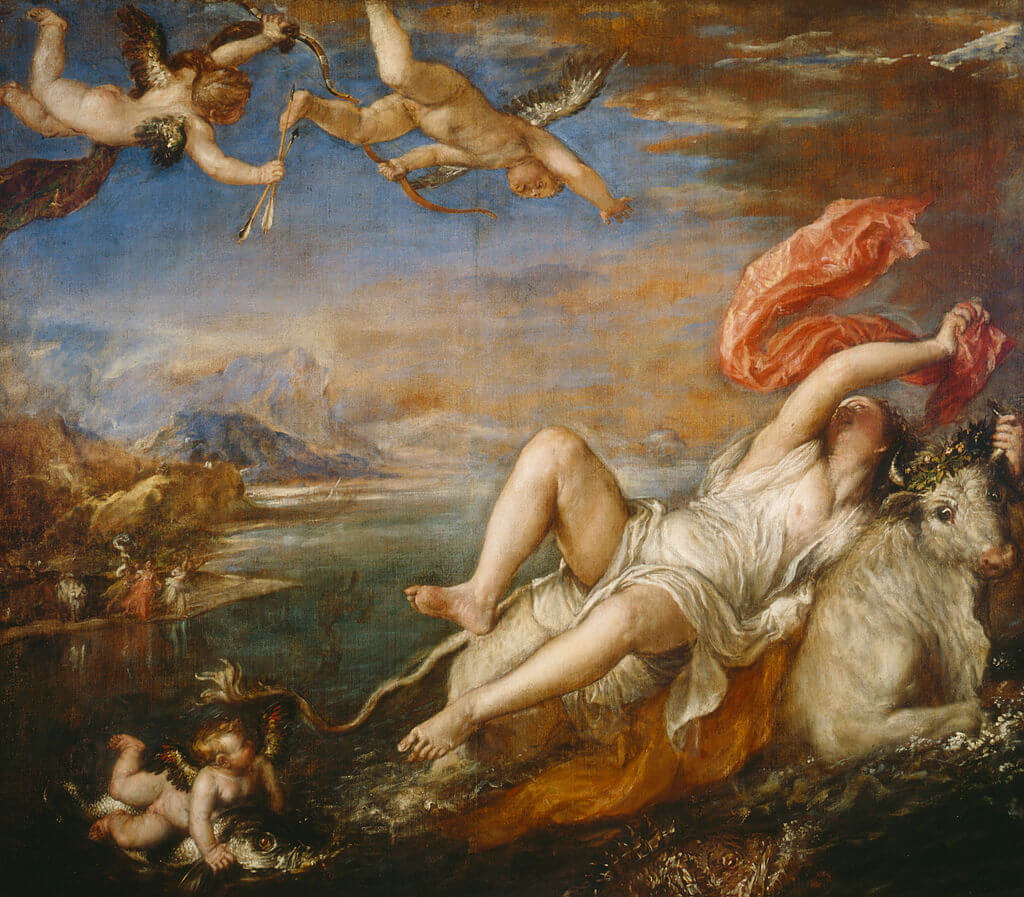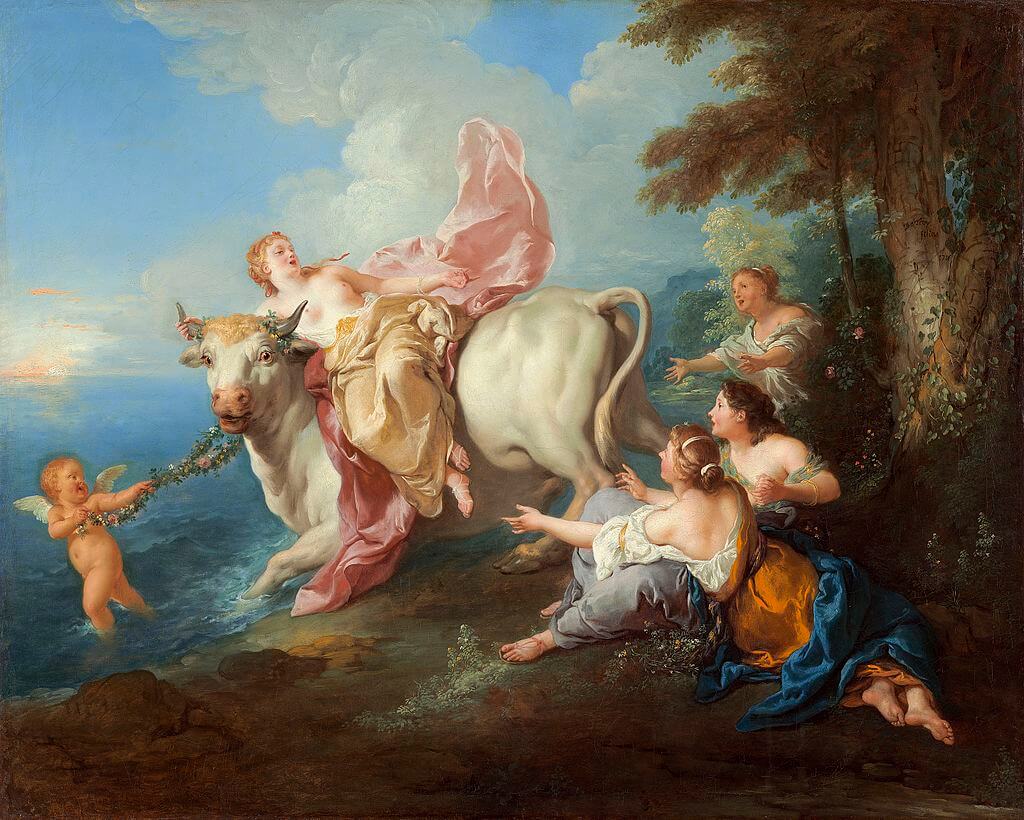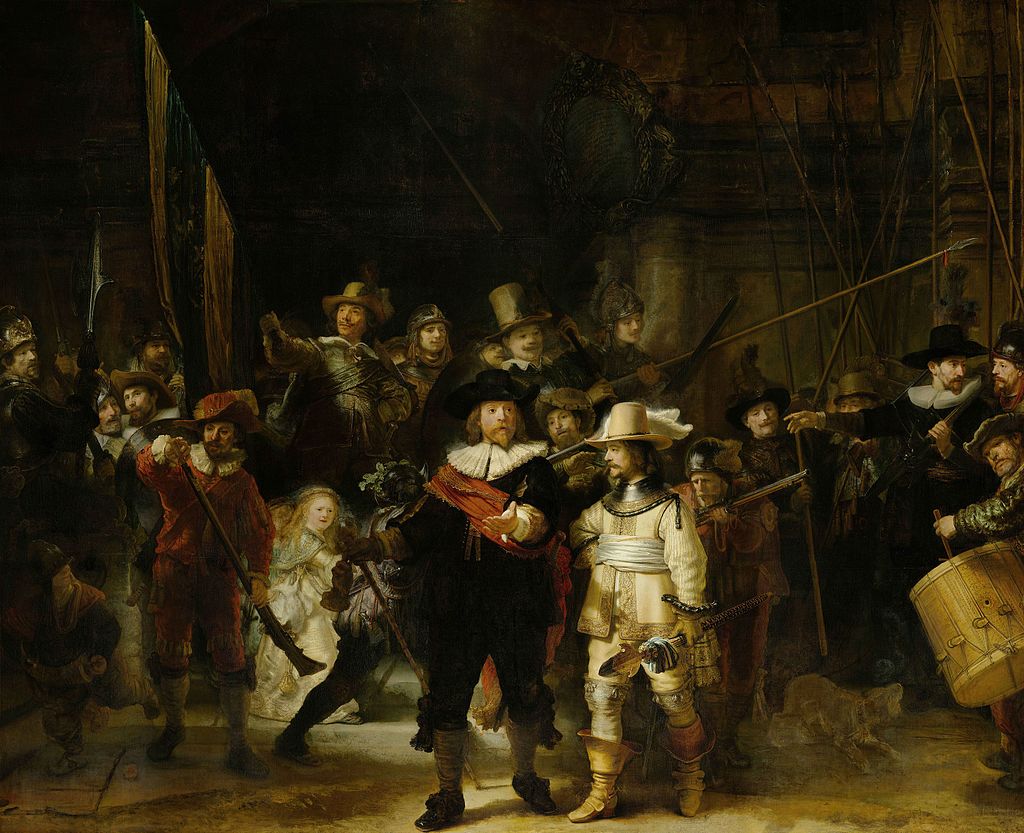|
Where? Room E204 of the J. Paul Getty Museum
When? 1632 What do you see? The Ancient Roman god Jupiter (Zeus in Greek mythology) is disguised as a beautiful white bull. He just seduced Europa and takes her away on his back into the sea. He has his tail up as an indication that he is happy with the successful abduction. Europa sits on top of the bull, holding a horn with her right hand, and fearfully looks back at her servants on the shore. They are the Virgins of Tyre (where Europa lived as well), with whom Europa was playing before she got abducted. They watch in disbelief how Europa gets abducted. The woman in blue has dropped the flower garland they made for the bull in her lap and raises her hands up in the air. The other woman looks at Europa while folding her hands as if she resigns in Europa’s fate. In the background is the horse carriage with four horses that had brought Europa to the beach. The story of Jupiter and Europa? This story is based on the second book of Metamorphoses by the Roman poet Ovid (Amazon link to Metamorphoses). At the end of the second book, in lines 833 till 875, Ovid describes how Jupiter falls in love with Europa. She was the daughter of a king in an Eastern land. Jupiter asks his son Mercury to go to that land and drive the herd of royal kettle to the beach, where Europa is playing with her servants. Jupiter disguises himself as a tame white bull and puts himself among the royal kettle. Europa recognizes his beauty and starts to play with him. While a bit afraid at first, she eventually climbs on his back, and Jupiter takes that opportunity to walk into the water and escape with her on his back. This story has also inspired other painters. Titian painted The Rape of Europa in the Isabella Stewart Gardner Museum in Boston, and Jean-François de Troy painted The Abduction of Europa in the National Gallery of Art in Washington, DC.
Background: This painting is one of only few paintings by Rembrandt in which he included an extensive landscape. The Getty Museum acquired it in 1995 for about $27 million, which was a new record for a Rembrandt painting at that time. They bought it together with another painting by Rembrandt, Daniel and Cyrus before the Idol Bel, which is also still in the Getty Museum.
Who is Europa? A figure in Greek mythology. She was born as the daughter of a king of a land somewhere near current-day Lebanon. She is primarily known by the story on her abduction by Jupiter who brought her to Crete. She was still a virgin before the got abducted.
Jupiter and Europa get three children together: Minos (who will become the king of Crete), Rhadamanthus, and Sarpedon. After their death, these three sons became the judges of the Underworld. The continent of Europe is named after Europa, as Jupiter took her from Asia to this new continent. Also, one of the moons of the planet Jupiter is named after her (many moons of Jupiter are named after lovers of Jupiter). Who is Rembrandt? Rembrandt Harmenszoon van Rijn was born in Leiden, The Netherlands, in 1610. In 1631, he moved to Amsterdam where he initially ran a very successful painting business. He painted The Abduction of Europe in the year after his arrival in Amsterdam. He stayed there for the rest of his life and died in 1665. During his life, he experienced many challenges, like the death of his wife and children and financial trouble, but he always remained productive. Nowadays, he is considered one of the most famous artists that ever existed. Rembrandt did not paint many mythological paintings during his career. He preferred religious subjects, like Saul and David in the Mauritshuis in The Hague, or portrait paintings of individuals or groups, like he did in his famous The Night Watch in the Rijksmuseum in Amsterdam.
Fun fact: Rembrandt included some great details in this painting.
Interested in a copy for yourself: Poster or canvas.
Written by Eelco Kappe
References:
0 Comments
Leave a Reply. |
Categories
All
|
- Home
- Blog
-
Museums
- Alte Pinakothek
- Art Institute of Chicago
- Baltimore Museum of Art
- Barber Institute of Fine Arts
- Bargello
- Barnes Foundation
- British Museum
- Church of Sant’Anastasia
- Cleveland Museum of Art
- Courtauld Institute of Art
- Detroit Institute of Arts
- Frans Hals Museum
- Galleria Borghese
- Gallerie dell'Accademia
- Getty Museum
- Guggenheim
- Hermitage Museum
- Kunsthistorisches Museum
- Kunstmuseum Basel
- Legion of Honor Museum
- Louvre
- Mauritshuis
- Metropolitan Museum of Art
- Musee d’Orsay
- Museum of Fine Arts in Boston
- Museum of Modern Art
- National Gallery in London
- National Gallery of Art
- National Museum in Poznań
- Norton Simon Museum
- Ny Carlsberg Glyptotek
- Palace of Versailles
- Palazzo Pitti
- Palazzo Vecchio
- Petit Palais
- Philadelphia Museum of Art
- Prado
- Pushkin Museum
- Ravenna Art Museum
- Rijksmuseum
- San Diego Museum of Art
- Santa Maria delle Grazie
- St. Peter's Basilica
- Städel Museum
- Statens Museum for Kunst
- Tate Britain
- Tate Modern
- Timken Museum of Art
- Uffizi
- Vatican Museums
- Wallace Collection
-
Artists
- Altdorfer
- Anguissola
- Berlin Painter
- Bosch
- Botticelli
- Boucher
- Bronzino
- Bruegel the Elder
- Brunelleschi
- Cabanel
- Caillebotte
- Canova
- Caravaggio
- Carpeaux
- Cezanne
- Cimabue
- David
- Degas
- Delacroix
- De Maria
- Donatello
- El Greco
- Fontana
- Fra Angelico
- Fragonard
- Gauguin
- Gentileschi
- Gericault
- Gonzalez-Torres
- Goya
- Hals
- Hogarth
- Hokusai
- Ingres
- Leonardo da Vinci
- Lippi, Filippo
- Longhi, Barbara
- Lorrain
- Makovsky
- Manet
- Massys
- Matisse
- Merian
- Michelangelo
- Mochi
- Modigliani
- Monet
- Panini
- Parmigianino
- Perugino
- Picasso
- Pisanello
- Raphael
- Rembrandt
- Renoir
- Reynolds
- Rivera
- Rodin
- Rubens
- Scultori
- Seurat
- Steen
- Tintoretto
- Titian
- Toulouse-Lautrec
- Turner
- Uccello
- Van der Weyden
- Van Dyck
- Van Eyck
- Van Gogh
- Van Hemessen
- Vasari
- Velazquez
- Vermeer
- Veronese
- Vigée Le Brun
-
Locations
- Books
- About Us






